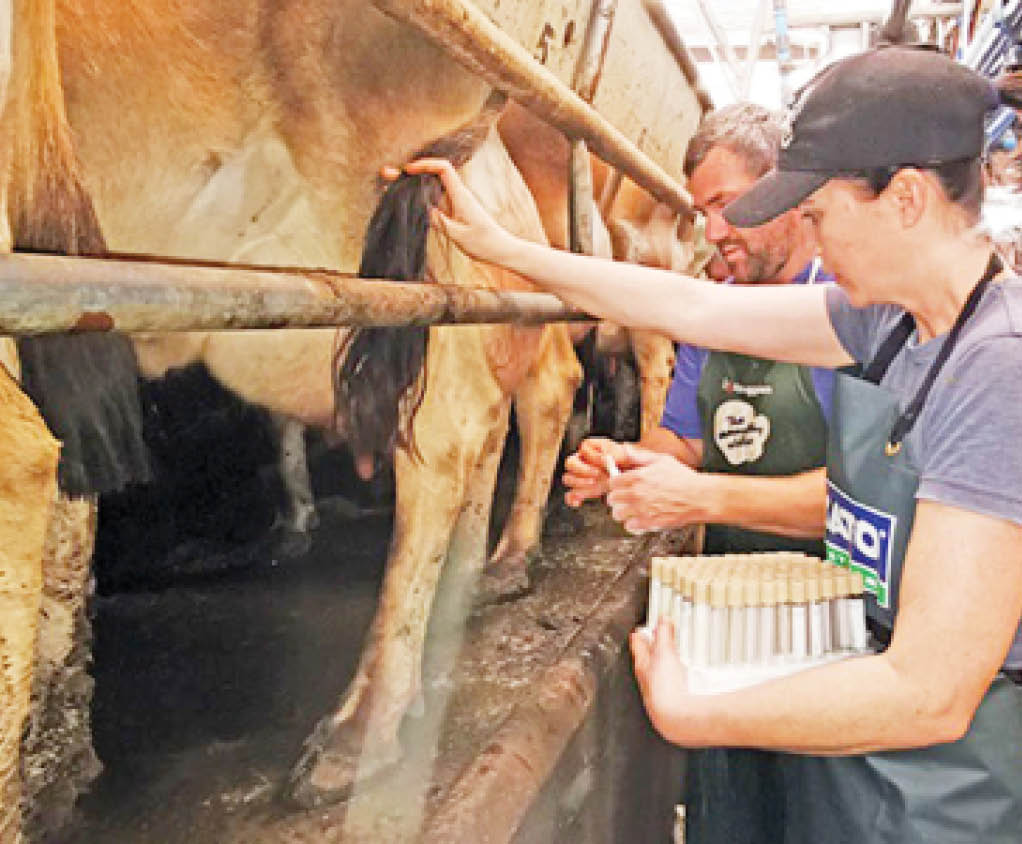AGRO SOLUTIONS: Managing mastitis in dairy cows
Mastitis can cause devastating economic losses for a dairy farmer, reports the Farmer Weekly. Staphylococcus aureus (staph) is one of the most difficult mastitis-causing bacteria to eliminate from a dairy herd. Not only is it one of the most damaging and costly diseases of dairy cows, it is also very contagious. For every clinical case […]

Taking samples of staph from a cow
Mastitis can cause devastating economic losses for a dairy farmer, reports the Farmer Weekly.
Staphylococcus aureus (staph) is one of the most difficult mastitis-causing bacteria to eliminate from a dairy herd. Not only is it one of the most damaging and costly diseases of dairy cows, it is also very contagious.
For every clinical case of mastitis that’s visible to the naked eye, there can be 20 more cases of subclinical mastitis that can only be identified in a laboratory.
“Subclinical mastitis is responsible for more than 80 per cent of mastitis losses. This is why most farmers vastly underestimate economic losses due to mastitis,” says Onderstepoort udder health expert, Prof Inge-MariéPetzer.
A cow with intra-mammary infection with staph can infect up to seven other cows that are milked with the same unit if the unit is not disinfected in-between the cows. It can be devastating to a farmer, with reported losses of 45 per cent quarter and 15 per cent infected cow.
However, staph can be controlled and eradicated from a herd through effective farm management, says Inge-Marié.
“Farmers need to take a proactive approach if they want to overcome staph outbreaks. This includes the early detection of bacteria, achieving optimal parlour management and hygiene, and critically analysing every point within the dairy process,” Ingé-Marie advises.
Eradicating staph
To eradicate staph from a herd, says Inge-Marié, three distinct approaches are required:
Good management: This is by far the most important factor, not only in preventing new cases of staph but also in dealing with positive cases.
Treatment: This is almost twice as effective during the dry period as it is during lactation. However, treatment has a limited chance of success and is usually reserved for clinical cases and valuable animals.
Inactivation of incurable quarters and culling: Culling of chronically infected cows is the cornerstone of eliminating staph from a dairy herd.
Success with staph starts with implementing good management
Up to 30 per cent of humans carry staph in their upper respiratory tracts. Infected people in close contact with dairy cows can transmit it to their udders.
It is important to test the carrier status of people in close contact with cows. Monitor and limit those who touch the udders.
Milkers should follow good personal hygiene to prevent the spread of bacteria. This includes wearing masks and rubber gloves, and disinfecting hands.
Don’t introduce new animals into the herd without quarter samples. Don’t buy a cow that has tested positive for staph or streptococcus agalactiae. Improve the bio-security in your dairy herd.
Improve cow resistance to staph by breeding for traits, such as genetic resistance. Milk heifers first to prevent older cows from infecting them. Cows fresh in milk should then be milked and the mastitis group or staph-positive cows last.
Dirty teats must be washed and dried very well. If teats are not visibly dirty, a dry wipe with a disposable paper towel is the best method. Limit the use of water to an absolute minimum.
Always use a strip cup at milking. It supplements the pre-milking stimulation of the milk let-down and prevents over-milking when clusters are attached to the teats. It also flushes out bacteria that colonise the teat keratin between milkings.
A pre-teat dip is thought to be important for the control and prevention of staph. Any open lesion poses a high risk for the multiplication of staph and should be treated immediately.
Never over-milk. This will damage the teat canal and prevent it from closing properly. This creates a permanent highway for bacteria to enter the udder. Effective post-milking teat dipping can reduce new udder infections by contagious organisms by up to 50 per cent. Post-milking teat dip must be applied to cover the bottom two thirds of all teats, because the teat canal stays open for at least 30 minutes after milking.
Back-flushing of cluster units with disinfectant (with a short action) is effective in limiting the spread of staph in a herd. It lowers the bacterial load on the liners, but not on the teat skin.
Prevent damage to teats by ensuring milking machine settings, maintenance and machine use are correct.
Source: Farmers Weekly
